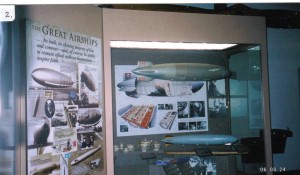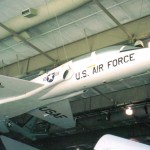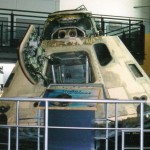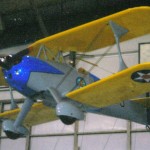By Jim Stanley

A Lockheed T-33, a two-seated trainer variant of the P-80 Shooting Star, guards the entrance to the Frontiers of Flight Museum.
In 1988, U.S. Senator Kay Bailey Hutchinson, Jan Collmer and William E. Cooper founded the Frontiers of Flight Museum at Dallas Love Field. Initially, they intended to exhibit the artifacts, documents and photographs of the History of Aviation collection, which aviation historian George E. Haddaway donated to the University of Texas. Since then, the museum has added an extensive collection of artifacts and aerospace vehicles, covering aviation history from the Wright brothers to space and rocketry.
Today, the mission of the museum is to create and sponsor educational programs for schools and public groups, to preserve the UT collection and expand the museum’s collection, and to promote the contribution of aerospace to the community and develop a resource of national significance.
The museum began with one Sopwith Pup, which hung in the Love Field terminal building for almost 15 years. That famous World War I fighter now occupies a place of honor in a new gallery.
“In 2004, we were awarded a federal grant and were able to build this facility, which includes a renovated original hangar,” said Dan Hamilton, executive director. “We now have 100,000 square feet. It keeps us busy.”
The museum is located at the southern boundary of Love Field, on Lemmon Avenue. Displayed outside in the parking lot is a Jupiter launch vehicle. Developed from the Army’s Redstone missile, a special adaptation became the Jupiter C. This vehicle launched America’s first satellite, Explorer I, into orbit on Jan. 31, 1958, from Cape Canaveral, Fla.
Exhibits in the museum gallery are arranged chronologically around its perimeter. They include Early Flyers and Lighter Than Air, where the huge LZ 129 Hindenburg is pictured. The zeppelin was 804 feet long and filled with seven million cubic feet of hydrogen. It carried more than 100 passengers and crew, and made nearly 40 nonstop flights across the Atlantic Ocean before it crashed at Lakehurst, N.J., on May 6, 1937. Thirty-six people perished in the accident.
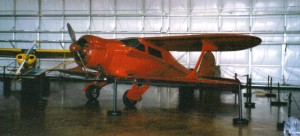
The Beech Model 17 Staggerwing is an example of plush, high-performance aircraft from the early 1930s.
Artifacts include the largest unburned piece of the Hindenburg, the radioman’s chair, and a china service from the German Graf Zeppelin 1. From U.S. Navy’s blimps came structural components from the Akron, and propellers from the Shenandoah and Los Angeles.
The Golden Age of Aviation covers general commercial aircraft of the 1920s and ’30s. The World War II exhibit showcases the Dallas/Fort Worth area’s contribution to aviation’s vital role in the conflict. This special exhibit commemorates the No. 1 British Flying Training School at Terrell, Texas, where 2,000 British fighter pilots trained during World War II. The 5th Ferrying Group, based at Love Field, was home to Women Airforce Service Pilots who performed vital tasks during the war. The WASP members delivered B-24 Liberators from Fort Worth’s Consolidated plant, P-51 Mustangs from the North American plant at Grand Prairie and P-38 Lightnings from the Lockheed modification center at Love Field. Uniforms of men and women pilots and more than 200 models of aircraft representing all nations involved in the war are also exhibited here.
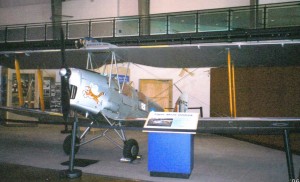
The Royal Air Force converted the de Havilland DH-82A, a popular 1930s civil trainer, to military use during WWII.
Other exhibits include Cold War, Southeast Asia Conflict and Modern Air Power displays. Some of the items on display have been loaned to the museum, including Navy carrier-based Vought A-7 Corsair II attack aircraft and Vought F-8 Crusader supersonic fighter displays from the Vought Aircraft Heritage Foundation and the Apollo 7 command module, provided by the Smithsonian National Air and Space Museum.
The museum’s Education Experience Center, located in the renovated hangar east of the gallery, offers attractions for children and young adults. At the preschool center, children are given wings to wear while they land on a cushioned runway; the center features a control tower model and a video screen showing adventures of Jay Jay the Jet Plane.
The middle school center contains interactive displays and kiosks to teach the concepts of flight, while the high school center features a full-size Southwest Airlines Boeing 737 nose and cockpit and an interactive display called “Careers in Aviation.” Also located in the education wing is the world’s only Lockheed SR-71 Blackbird flight simulator.
The museum has a 1,300-square-foot classroom and a 200-seat multimedia theater, a gift
For more information, visit [http://www.flightmuseum.com].
- The Northrop T-38 Talon is one of the few supersonic jet trainers currently in service.
- This Apollo 7 command module was the first of the three-man Apollo vehicles to achieve earth orbit.
- A Southwest Boeing 737 nose section serves as a hands-on high school exhibit.
- The U.S. Navy and several foreign countries used the Curtiss Hawk fighter during the late 1930s.
- The North American AT-6 Texan/SNJ was the advanced trainer for all U.S. flying services during WWII.
- A Grumman A7B Corsair is loaded for combat.
- This aircraft is one of three surviving Lear Fan 2100s.












